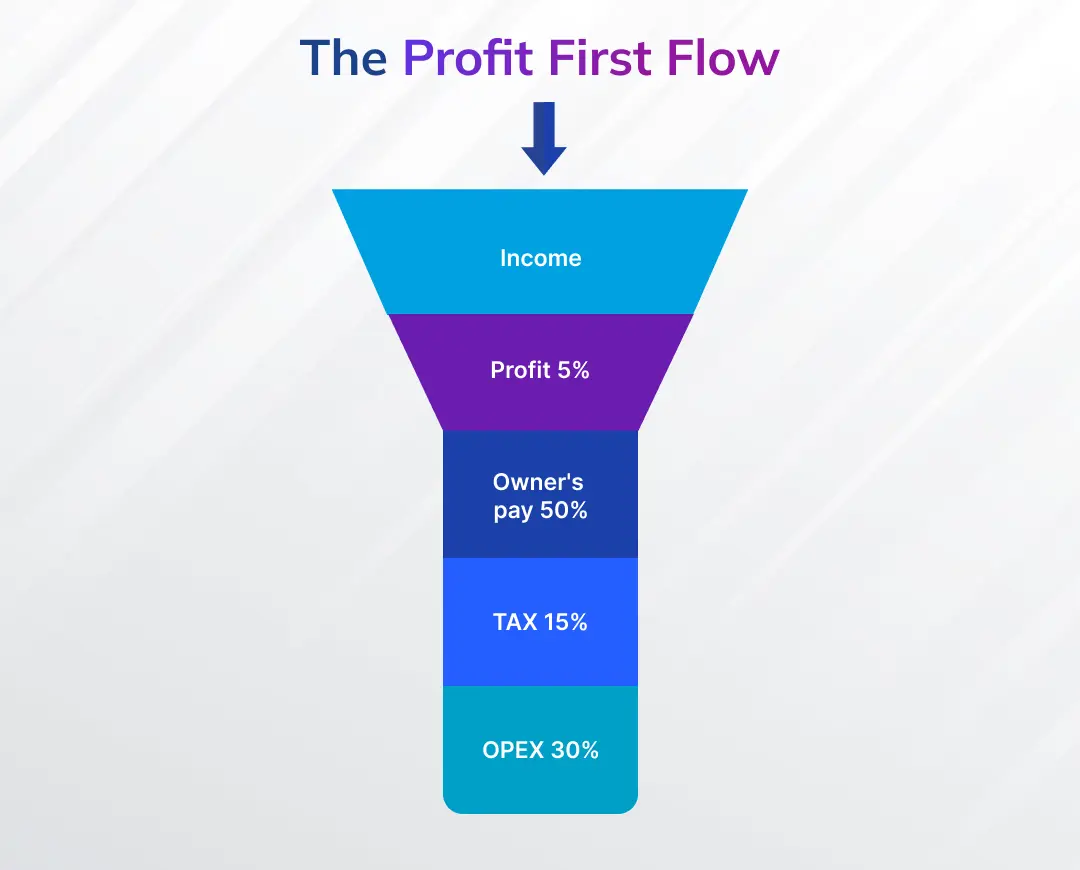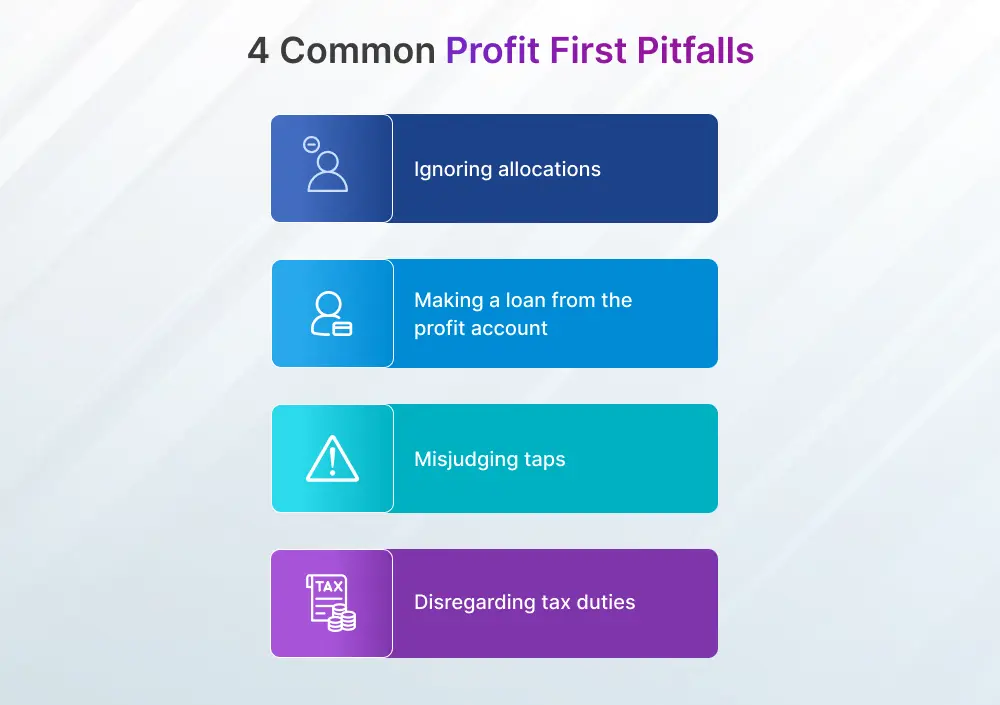.webp)
Content
Although handling finances can seem like a never-ending battle to many small business owners and startup founders, running a business is an exciting experience.
Unfortunately, profits appear to disappear even in the face of robust sales. Remember, profit is what remains after deducting expenses in traditional accounting. And, burnout, debt, and cash flow issues are consistent in this outdated strategy.
But here’s the good news: Profit First Accounting is a straightforward yet effective technique that reverses the equation: you take your profit first, followed by expenses.
The method, developed by businessman Mike Michalowicz, is currently used by more than 175,000 organizations globally. It combines behavioral research and financial reasoning to generate steady, long-term profit.
Profit is not an event. Profit is not something that happens at the end of the year or the end of your five-year plan, or someday. Profit isn't even something that waits until tomorrow. Profit must happen now and always. Profit must be baked into your business. Every day, every transaction, every moment. Profit is not an event. Profit is a habit.
Mike Michalowicz, Businessman and Author Profit First (2017)
This guide explains how Profit First Accounting operates, why it works, and how you can use it immediately. Profit First might be the financial system that makes all the difference, regardless of whether you’re a startup or an established company.
What Is Profit First Accounting?
Profit First Accounting is a cash management technique for businesses that reverses the conventional approach by prioritizing profit over expenses, rather than considering it as an afterthought.
Profit First ensures that you take your profit upfront and use what’s left over to manage your costs, rather than spending what you make and hoping for something left over.
This is how thinking has changed:
Profit First is essentially a business application of the “envelope budgeting method,” a concept commonly used in personal finance. For profit, owner’s compensation, taxes, and running expenses, income is purposefully divided into distinct bank accounts. This arrangement establishes financial limits that direct expenditure and encourage more prudent, frugal choices.
The idea is based on behavioral psychology, specifically Parkinson’s Law, which states that labor (or, in this example, expenditure) increases in proportion to available resources. Businesses naturally become more efficient without sacrificing their profitability by restricting the amount of money available for spending.
The growth-at-all-costs mentality that many entrepreneurs are taught is challenged by Profit First. Although top-line revenue is the focus of conventional thinking, this approach guarantees that firms remain cash-positive, lean, and sustainable – even in the face of sales fluctuations.
How Profit First Accounting Differs from Traditional Accounting
Here’s an easy comparison:
Profit is reported after In traditional accounting, which means that many companies appear lucrative on paper, yet struggle financially. Earnings First promotes healthier operations by placing a higher priority on actual, cash-in-bank earnings.
Step-by-Step Process of How Profit First Accounting Works
But how does the Profit First accounting approach function in real life? It’s a methodical, repeatable approach to disciplined cash flow management that goes beyond a simple mental adjustment.
You establish financial transparency and control immediately by allocating your revenue according to a regular schedule and separating it into designated accounts.
Here’s a step-by-step guide to implementing and managing Profit First in your company without the need for complex spreadsheets.
1. Set Up Multiple Bank Accounts
This is the system’s cornerstone. Every account serves a distinct function:
- Income Account: This is where all business revenue is initially deposited before being distributed into other accounts.
- Profit Account: Here, a predetermined percentage is moved as actual profit.
- Owner’s Pay Account: This guarantees payment to the owner or founder.
- Tax Account: To pay for sales tax, income tax, or VAT duties.
- Operating Expenses (Opex): This account is used to cover all other business expenses not included in the other accounts.
Depending on their objectives, several companies create extra accounts (such as Debt Repayment or Vault).
2. Determine Allocation Percentages
Selecting the proportion of incoming revenue that goes into each account is the next step after setting them up. These are your financial road map and are known as Target Allocation Percentages (TAPs).

TAPs specify the distribution of income. This is an illustration depending on the size of the company:
3. Schedule Regular Allocations
To transfer percentages from your income account to the others, select two specific dates (for example, the 10th and the 25th). To keep discipline, make this a non-negotiable process that is preferably automated.
4. Pay Expenses with What’s Left
Your Operating Expenses (Opex) account should be used solely to cover all business expenses. This ensures that expenditures are not inflated by unrealized revenue, but rather are based on what is available.
You can naturally reduce expenses, identify inefficiencies, and create a leaner, more financially disciplined organization by adhering to the Opex balance. The absence of funds is an indication to reduce spending or re-evaluate priorities.
Top 4 Benefits of Profit First Accounting
Thanks to careful reinvestment and financial clarity, Jennie Allen, the creator of Bayley & Sage, was able to grow her company from £1.5 million to £30 million without incurring debt by following a profit-first strategy.
Let’s examine this revolutionary system’s main advantages:
1. Better Control of Cash Flow
Profit First allocates every dollar as soon as it enters your company, giving your cash flow discipline and structure. With accounts set aside for particular uses, such as earnings, taxes, and operational costs, you can see where your money is moving in real time.
This strategy helps you stay on top of both short-term requirements and long-term ambitions, ensuring that you’re never caught off guard by financial shortages.
2. Builds a profit habit from day one
Profit First ensures that you set aside a portion of your profit with each deposit, eliminating the need to wait until year-end (or never) to receive a profit.
This process creates a profitable habit that lasts from the start. Even modest profit distributions support prudent and forward-thinking corporate actions, as well as a favorable financial outlook.
3. Helps prevent “bank balance accounting”
A common risky behavior that can lead to overspending and financial confusion is for small business owners to base their spending decisions solely on their bank balance.
By separating funds into accounts with distinct purposes, Profit First breaks this pattern and indicates how much money is available for each use.
This provides a more realistic view of your financial situation and helps curb impulsive, emotional spending.
4. Boosts owner confidence and decision-making
Your confidence as a business owner increases when your finances are well-organized, predictable, and under control. You can hire, invest, and scale more quickly and intelligently if you have a clear picture of your financial situation.
4 Potential Drawbacks and Challenges
1. Initial setup complexity (especially for non-finance founders)
Despite having a straightforward principle, the Profit First system might be intimidating to adopt at first, particularly for entrepreneurs who are not experienced in finance.
Target Allocation Percentages (TAPs), cash flow restructuring, and establishing numerous bank accounts can all require patience, accuracy, and a significant learning curve.
This complexity may cause adoption to be delayed or, in the absence of direction, result in implementation errors for companies that are already overburdened.
2. May require support to analyze real costs properly
Effective capital allocation requires a thorough understanding of your actual business expenses, which many small business owners often undervalue or overlook. Setting reasonable allocation percentages becomes challenging in the absence of accurate financial information.
To determine actual costs and optimize account allocations for sustainability, entrepreneurs frequently require assistance from a bookkeeper, accountant, or economic expert.
3. Resistance to change if existing systems are entrenched
When implementing Profit First, companies that have long employed traditional accounting techniques may encounter internal resistance.
Teams that are used to spending freely from a single account may object to the new arrangement, particularly if it places more stringent restrictions on them.
The necessary operational and emotional change might be substantial, especially in companies with key financial planning components.
4. Not a fit for every business without adjustment
There is no one-size-fits-all approach to Profit First. Without adjustments, the approach would be challenging to implement for companies with erratic cash flows, high upfront capital requirements, or thin margins (such as manufacturing or NGOs).
In many situations, strict adherence to the standard approach may put more strain on finances than it alleviates. To ensure the system functions well, these companies often need to modify their schedules, account structures, or percentages.
4 Common Mistakes to Avoid

1. Ignoring Allocations
You lose system integrity and momentum if you “forget” to allocate. Maintaining a Single Account Profit relies on psychological clues first. Behavior is altered when separate balances are seen.
2. Making a loan from the Profit Account
Your future is being robbed by it. Profit is precious; it should only be used for emergencies or quarterly payouts.
3. Misjudging TAPs
Cash shortages result from being overly aggressive too soon. Every quarter, review and make adjustments.
4. Disregarding Tax Duties
Your finances may be derailed by unforeseen liabilities resulting from failing to account for taxes. Avoid year-end worry by treating taxes as an unavoidable expense and setting aside funds for them regularly.
How Invensis Can Help Implement Profit First Accounting
To make the Profit First strategy easier to adopt, Invensis provides professional outsourced accounting and financial services. Invensis takes care of the heavy lifting, from creating multiple bank accounts to determining clever allocation percentages.
Our staff ensures tax compliance, tailors strategies to your business model, and provides continuous performance monitoring through transparent and up-to-date financial reporting.
With our help, you may steer clear of typical errors, practice financial restraint, and concentrate on expansion—all while knowing that your profit is always safeguarded.
Collaborate with Invensis to properly execute Profit First.
Conclusion
By placing profit at the center of your company rather than as an afterthought, the Profit First approach completely upends standard accounting. It provides small businesses with the tools they need to expand confidently and sustainably by fostering financial clarity, promoting cash discipline, and reducing stress.
However, you don’t have to go through the process by yourself. Implementing Profit First becomes not only manageable but revolutionary with the correct direction and assistance.
From the outset, let Invensis be your partner in building a successful and long-lasting company.
FAQs
Discover Our Full Range of Services
Click HereExplore the Industries We Serve
Click HereBlog Category
Related Articles

Find the leading accounting firms in Singapore trusted by businesses for audit, tax, and advisory services.
November 6, 2025
|

Explore the leading accounting firms in South Africa providing expert audit, tax, cloud accounting, and payroll services. Learn about their key features and unique offerings.
November 6, 2025
|

Explore what project accounting is, how it works, and why it’s essential for businesses. Understand key principles, revenue recognition methods, and best practices to improve your knowledge.
October 7, 2025
|
Services We Provide
Industries We Serve







.webp)